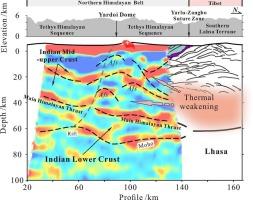北喜马拉雅带东部地壳堆积对加厚的定量贡献
IF 2.6
3区 地球科学
Q2 GEOCHEMISTRY & GEOPHYSICS
引用次数: 0
摘要
喜马拉雅造山带下的印度大陆地壳厚度显著(可达78公里),约为全球大陆地壳平均厚度的两倍。然而,其深层地壳结构和变形机制,如分布韧性流动与高强度堆积,仍然存在争议。这项研究部署了一个130公里长、密集的短周期地震仪节点阵列,以调查北喜马拉雅带东部的地壳结构。应用p波接收函数共转换点(CCP)叠加法对精细地壳结构进行成像。此外,我们开发了一种基于邻域算法的速度反演方法,该方法将接收函数与地壳H-κ参数相结合,推导出速度结构。研究结果表明,中上部地壳中的高速Yardoi圆顶具有短波长、反形式的堆叠样式。喜马拉雅主逆冲(MHT)作为一个分离装置,有效地将上层堆积系统与垂直增厚的下地壳分离开来。我们提出了一个混合地壳增厚模型,其中中上部地壳逆冲叠加对总厚度的贡献占主导地位(约占70%)。这是由于印度地壳锋面的长期热减弱,持续的高温促进了局部韧性剪切和地壳向上堆积。重要的是,持续的造山热条件保存了这种超厚的地壳,为碰撞系统中的大陆增厚提供了范例。本文章由计算机程序翻译,如有差异,请以英文原文为准。

Quantifying crustal stacking contribution to thickening of the eastern Northern Himalayan belt
The Indian continental crust beneath the Himalayan orogenic belt exhibits remarkable thickness (up to 78 km), approximately twice the global average for continental crust. However, its deep crustal structure and deformation mechanisms, such as distributed ductile flow versus high-intensity stacking, remain debated. This study deployed a 130 km-long, dense nodal array of short-period seismometers to investigate the crustal architecture of the eastern Northern Himalayan Belt. We applied the P-wave receiver function Common Conversion Point (CCP) stacking method to image fine crustal structures. Furthermore, we developed a neighborhood algorithm-based velocity inversion method that integrates the receiver functions with crustal H-κ parameters to derive the velocity structure. Our results reveal that the high-velocity Yardoi Dome within the mid-upper crust exhibits a short-wavelength, antiformal stacking style. The Main Himalayan Thrust (MHT) acts as a décollement, effectively decoupling the upper stacking system from the vertically thickening lower crust. We propose a hybrid crustal thickening model wherein mid-upper crustal thrust stacking dominantly contributes (approximately 70 %) to the total thickness. This is attributed to long-term thermal weakening along the Indian crustal front, where sustained high temperatures facilitated localized ductile shearing and upward crustal stacking. Critically, persistent orogenic thermal conditions preserve this ultra-thickened crust, offering a paradigm for continental thickening in collisional systems.
求助全文
通过发布文献求助,成功后即可免费获取论文全文。
去求助
来源期刊

Tectonophysics
地学-地球化学与地球物理
CiteScore
4.90
自引率
6.90%
发文量
300
审稿时长
6 months
期刊介绍:
The prime focus of Tectonophysics will be high-impact original research and reviews in the fields of kinematics, structure, composition, and dynamics of the solid arth at all scales. Tectonophysics particularly encourages submission of papers based on the integration of a multitude of geophysical, geological, geochemical, geodynamic, and geotectonic methods
 求助内容:
求助内容: 应助结果提醒方式:
应助结果提醒方式:


